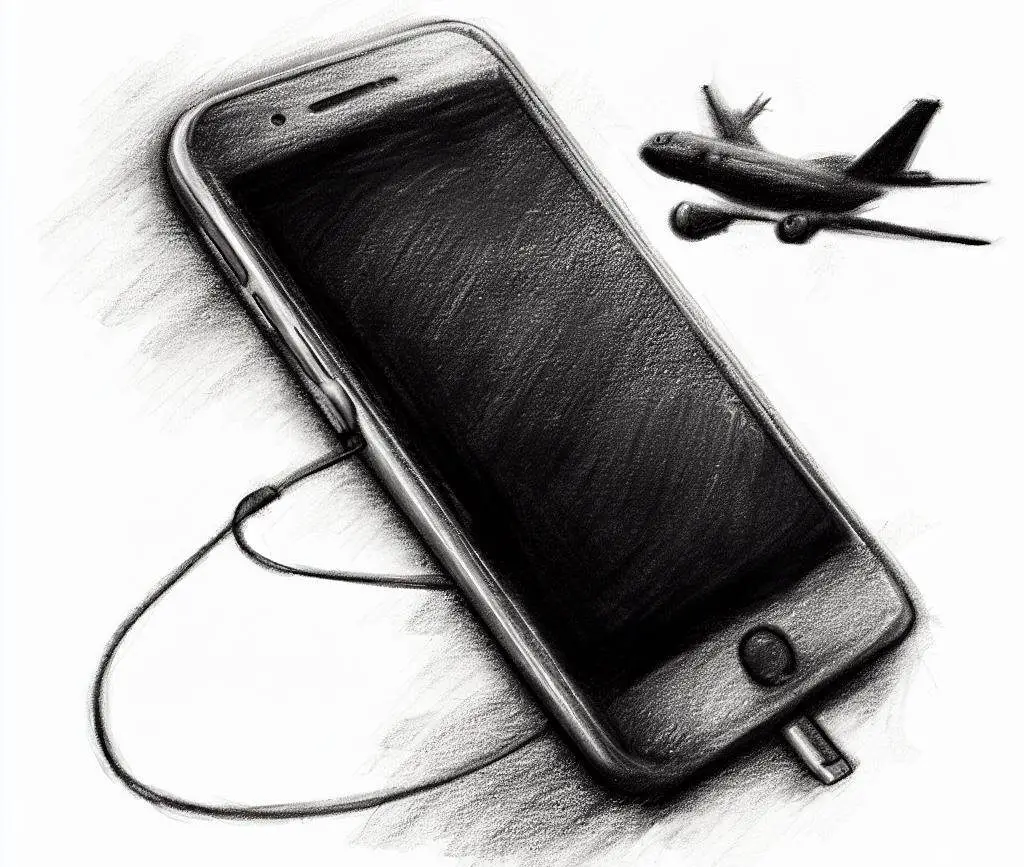Airplane mode is a common yet often misunderstood feature on mobile devices. Many of us have encountered the need to enable airplane mode while boarding a flight, but does it really save battery life?
In this article, we will discuss the impact of airplane mode on battery life and when it might be beneficial to use it.
When you enable airplane mode, all wireless communication methods on your device are disabled, including Wi-Fi, Bluetooth, and cellular connections. By blocking your device from constantly pinging and searching for nearby cell towers, it conserves battery life.
However, the trade-off comes with losing the ability to communicate with other devices, access the internet, or send and receive calls and text messages. With these limitations in mind, understanding when to enable airplane mode can help you make the best decision for your needs.
Quick Answer: Does Airplane Mode Save Battery?
- Airplane mode conserves battery by disabling wireless communication methods on your device
- Enabling airplane mode comes with the trade-off of losing communication and internet access
- Using airplane mode judiciously can help extend battery life in certain situations
How Airplane Mode Saves Battery
Turning Off Cellular Services
In Airplane Mode, one of the primary ways we save battery life is by turning off cellular services. Our devices are constantly pinging and searching for nearby cell towers to maintain a strong connection, even when we’re not actively using them.
By blocking the device from performing this task, we significantly reduce the amount of energy it consumes, thus prolonging battery life.
Disabling Wi-Fi and Bluetooth
Another key aspect of Airplane Mode is that it disables Wi-Fi and Bluetooth connections.
Both of these wireless communication methods can be quite taxing on our devices’ batteries.
By disabling them, we can ensure that our device is not continually scanning for, or maintaining, connections with other devices and networks. This further reduces battery drain and helps to extend the device’s overall usage time.
Reducing Background Processes
Airplane Mode not only helps conserve battery by limiting wireless connectivity but also by reducing the number of background processes our devices need to perform.
When in Airplane Mode, our phones and tablets are no longer receiving notifications, updating apps, or synchronizing data. As a result, fewer processes are running in the background, which significantly decreases the amount of battery usage on our devices.
In summary, Airplane Mode saves battery life by turning off cellular services, disabling Wi-Fi and Bluetooth connections, and reducing the number of background processes running on our devices. By doing so, we can extend the length of time our devices can be used before needing a charge.
When to Use Airplane Mode
Airplane mode is not only useful during flights, but it can also be helpful in various other situations. We will discuss a few instances when using airplane mode could be beneficial for us.
- First and foremost, we use airplane mode during air travel. This is primarily to prevent our devices’ signals from interfering with the aircraft’s systems. Turning on airplane mode disables wireless communication methods like Wi-Fi, Bluetooth, and cellular connections, ensuring that our devices do not cause any disruption on board.
- Another situation when we may want to use airplane mode is to save battery life. As our devices constantly ping and search for nearby cell towers while connected, this drains power.
By enabling airplane mode, we can save some battery life without the need to completely shut down our devices. This can be helpful in situations like hiking or camping, where we might need to conserve battery life for an extended period.
- Additionally, we can use airplane mode when we desire some interrupted time. In today’s digital age, we are constantly bombarded with notifications, calls, and messages.
Turning on airplane mode helps us disconnect and focus on the task at hand without being distracted by incoming notifications. This can be particularly useful in situations like meetings, study sessions, or simply when we need a break from our screen.
Airplane mode also has another advantage: it can help our devices charge faster. When our devices are not connecting to networks and using battery to maintain connections, they require less power. By turning on airplane mode, we can potentially reduce the time it takes to charge our devices.
In conclusion, airplane mode is a helpful tool not only for air travel but also for saving battery life, creating uninterrupted time, and speeding up charging. By using it wisely, we can enhance our devices’ usage and efficiency.
Additional Battery Saving Tips
In this section, we’ll provide you with some additional tips to help you save battery on your smartphone or device. Remember, every little bit helps when trying to conserve power and prolong battery life.
Lowering Screen Brightness
One effective way to save battery is by lowering the screen brightness on your device. Most smartphones and tablets have adjustable brightness settings, allowing you to find the perfect balance between visibility and power conservation.
Additionally, some devices offer an automatic brightness adjustment feature, which adjusts the screen brightness based on the surrounding light levels. This can be a useful tool for extending battery life without sacrificing usability.
Using Low Power Mode
Many smartphones and tablets offer a built-in low power mode that can help conserve battery life. When activated, this mode typically limits certain power-hungry features and processes, providing a significant increase in battery life.
Low power mode is especially useful when you’re away from a power source or want to extend your battery life as much as possible without entirely turning off the features of your phone, such as receiving important calls or texts. Note that the specific settings and availability of low power mode may vary by device and operating system.
Closing Unused Apps
Lastly, closing unused apps can be an easy and effective way to save battery life. When we leave apps running in the background, they continue to consume system resources and power, even if we’re not actively using them.
By closing these apps, you free up system resources and potentially extend your battery life. On many devices, you can access the multitasking view to quickly close unused apps. However, some devices may require manual management of background processes through settings or third-party applications.
Battery Consumption in Mobile Devices
To summarize, the battery life of our mobile devices is influenced by various factors:
- Background Apps: It’s not uncommon for many applications to continue running in the background, even when we think they’ve been closed. GPS-based services, for example, like maps, apps, or games, are significant power consumers even when not actively in use.
- Wireless Connections: Our devices are consistently searching for and maintaining connections to cellular networks, WiFi, and Bluetooth. These often-unnoticed background processes substantially contribute to daily battery drain.
The Role of Airplane Mode in Extending Battery Life
A commonly suggested way to save battery is by using Airplane Mode. Here’s how it can potentially impact battery life:
- Function: Airplane Mode disables all wireless connections on our devices. This includes cellular networks, WiFi, and Bluetooth. By doing so, it can lead to some battery savings as it stops the device from constantly managing these connections.
- Usage Impact: The effectiveness of Airplane Mode in preserving battery life greatly depends on our device usage patterns. If we’re continuously engaged with our devices, the savings might be marginal. However, for offline activities like reading or listening to downloaded content, Airplane Mode can help conserve some precious battery life.
Remember, while Airplane Mode isn’t a one-size-fits-all solution, it’s worth exploring if you’re keen on extending your device’s battery life.
Final Thoughts
In conclusion, enabling airplane mode does save battery on devices, as it turns off wireless communication methods such as Wi-Fi, Bluetooth, and cellular connections. This prevents the device from constantly searching for nearby cell towers or communicating with other devices. The amount of battery saved, however, depends on various factors like the device being used, its battery capacity, and the user’s usage patterns.
While airplane mode can be helpful in prolonging battery life, there is a trade-off in terms of connectivity. In this mode, users won’t be able to receive calls, send and receive text messages, or access the internet. Despite this limitation, airplane mode can be especially useful in situations where battery conservation is crucial, and when the device’s communication abilities are not required.
Nevertheless, it is essential to remember that each device performs differently, and the battery-saving benefits of airplane mode might vary. Ultimately, it is up to the user to decide when and how to utilize airplane mode, depending on their device and requirements.
Frequently Asked Questions
How does airplane mode affect battery life?
Airplane mode can indeed help save battery life on your device. By disabling your device’s cellular connection, Wi-Fi, Bluetooth, and GPS features, airplane mode can conserve battery power since these features use a significant amount of energy, especially when the device is constantly searching for a signal or connection.
Can airplane mode help my device charge faster?
Yes, enabling airplane mode while charging your device can potentially help it charge faster. With most wireless features disabled, there will be less power drawn by your phone for these services, which allows more power to be directed towards charging the battery.
Is it safe to leave my device on airplane mode?
It is safe to leave your device on airplane mode for extended periods of time. However, keep in mind that you won’t be able to make or receive phone calls, send or receive text messages, or access the internet while airplane mode is enabled.
What is the impact of airplane mode on battery health?
Using airplane mode can have a positive impact on your battery’s health in the long term, as it reduces the strain on the battery by minimizing the constant search for signals and connections. This can help extend the overall lifespan of your device’s battery.
How does airplane mode differ from power saving mode?
While both airplane mode and power saving mode aim to conserve battery life, they do so in different ways. Airplane mode disables all wireless communications, essentially cutting your device off from the outside world. Power saving mode, on the other hand, typically reduces screen brightness, limits background processes, and may even slow down the device’s performance to save power, while still maintaining some level of connectivity.
Can airplane mode help conserve data usage?
Yes, putting your device in airplane mode can help conserve data usage since it disables all wireless communication features of your device, including internet access through mobile data. However, you can still use Wi-Fi if you turn it on separately while in airplane mode.

